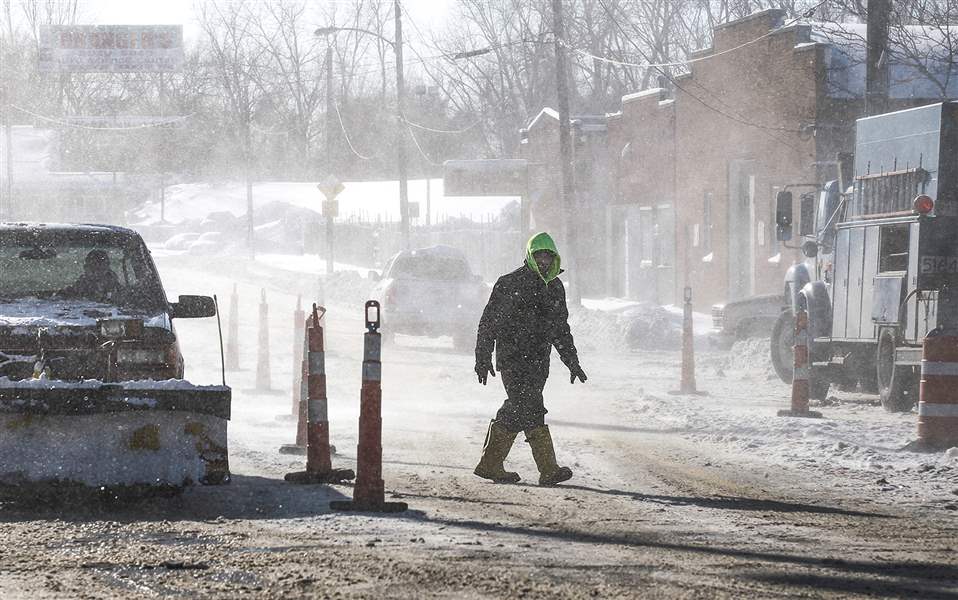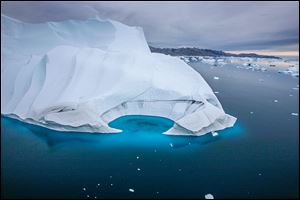
Climate change role in cold snap triggers debate
Hypothesis centers on massive loss of Arctic ice
1/12/2014
A city worker battles blowing snow in downtown Toledo. Monday’s conditions were blamed on the polar vortex.
THE BLADE/LORI KING
Buy This Image

A city worker battles blowing snow in downtown Toledo. Monday’s conditions were blamed on the polar vortex.
North America’s sudden fascination with the swirling, icy-cold air mass called the polar vortex has — if nothing else — expanded the meteorological vocabulary of millions of people, from late-night talk-show hosts tossing around their quips to ordinary people who share opinions on Facebook, Twitter, and other forms of social media.

But it’s also quietly opened up an ethical debate among mainstream scientists over how hard they should promote any and all possible links between climate change and the planetary effects of it, especially when they’re in early phases of research.
In today’s wired-up world of rapid, online communication, the lines can get blurred between perceptions of scientists doing their jobs and environmentalists crying wolf.
First, let’s set the stage with a description of what the polar vortex is.
Think of it as a cap above the Arctic Circle held in place by the jet stream, a band of strong wind that surrounds it. The jet stream gets its strength and energy from the convergence of cold air in the north and warm air in the south.
Under normal circumstances, the polar vortex spins at speeds of 100 mph or more.
Meteorologists say it’s like a child’s spinning top: When it’s whirling at full speed, it stays in place.
When a weak spot forms in the jet stream, the polar vortex can become unstable and wobble like a spinning top does when it’s slowing down. Or, as some experts said in interviews posted on the Internet, it can wobble like humans do after imbibing too much alcohol.
For whatever reason, the polar vortex strayed from home last week.
It shifted or may have even broken apart when the atmospheric pressure that normally holds it back weakened.
It brought Arcticlike wind chills of nearly minus 50 degrees to the Great Lakes region and the Upper Midwest, as well as unusual cold to the South last week. Toledo saw daily low record temperatures of minus 15 and minus 14 degrees.
The polar vortex hasn’t held that tight a grip on North America for about 20 years.
But it’s done a number on parts of Europe and northern Asia more recently.

An iceberg melts off the coast of Greenland. The Arctic has less than half the sea ice it did 50 years ago each September, the most critical month there because it’s the end of the summer thaw and the beginning of the refreezing period.
Nothing new
The polar vortex is not new, contrary to conservative talk-show host Rush Limbaugh’s assertion it was a concept created by the liberal media just last week to promote a climate-change agenda.
The term was used in academic papers as far back as 1940.
By the 1950s, it was in more than a dozen scientific articles. The American Meteorological Society said it included the term “polar vortex” in its very first AMS Glossary of Meteorology it published in 1959.
“It’s kind of interesting the media just picked up on the term,” meteorologist Jeff Masters said. “We’ve been using it for years.”
Mr. Masters is meteorology director for Weather Underground, a popular online weather-tracking firm founded in Ann Arbor. It’s now owned by the Weather Channel.
Climate change is, of course, a long-term trend people generally associate with global warming, even though scientists have said it is not completely synonymous with it.
Under certain models, a few parts of the world gradually may be getting cooler while the rest of the world swelters.
But that’s not what we’re talking about here.
Arctic sea ice
The debate over the polar vortex comes down to how much the massive loss of Arctic sea ice may be weakening the strength of the jet stream in the atmosphere, making the jet stream and the polar vortex unstable.
The Arctic has less than half the sea ice it did 50 years ago each September, the most critical month up there because it’s the end of the summer thaw and the start of the refreezing period.
Ice refreezes as temperatures drop, but not necessarily all of it does. And scientists who specialize in the study of ice argue the new layer is thinner and less robust than what has been there for centuries.

Box, left, and Francis.
Promoted largely by Jennifer Francis, a research professor for Rutgers University’s Institute of Marine and Coastal Sciences who specializes in Arctic atmospheric issues, the research is in its early stages. It is not widely embraced, nor is it widely refuted by mainstream science.
The hypothesis goes like this:
The loss of sea ice has warmed up the Arctic Ocean because it has exposed more water, allowing more sunlight and heat to be absorbed.
Ocean water, because it’s darker than ice and snow, warms faster and accelerates the melting.
A warmer ocean warms the lower atmosphere. That’s well-known among oceanographers.
But the question is how much of an effect that has on the jet stream’s ability to keep the polar vortex in check come winter.
“It’s a very plausible hypothesis. Weather patterns and the jet stream: It all fits together,” Ms. Francis said.
Young research
She has tested the hypothesis largely through computer modeling, using atmospheric data from the past 30 years.
Although the research has attracted several other meteorologists and oceanographers, it’s in its infancy.
Ms. Francis said she presented her research at a scientific conference for the first time in December, 2011. Her first paper was published in March, 2012.
“Clearly, there is much more work to do. We’re a lot closer to the beginning than the end,” she said.“It’s totally an emerging field.”
She sees last week’s buzz over that hypothesis as a positive thing. She credited Mr. Limbaugh’s cracks for drawing more attention to the issue and for bringing her research under the international spotlight.
“I see it as a great opportunity, actually, because people are listening. If they’re willing to listen to people who know what they’re talking about instead of those who don’t, they might learn something,” Ms. Francis said. “We were able to get out there in front of the public in ways we haven’t before.”
James Overland, an oceanographer in the National Oceanic and Atmospheric Administration’s Pacific Marine Environmental Laboratory in Seattle, said Ms. Francis’ hypothesis is an interesting one worthy of more research.
Mr. Overland described himself as a moderate supporter of it, someone who believes the Arctic’s melting has global consequences but hesitates to say if this is one of them.
“The changes in the Arctic itself are very big and ongoing and are beyond the point of no return,” Mr. Overland said. “It’s a real paradox. Just a little global warming gives a lot of Arctic warming.”
He said the warming ocean forms a “bubble of warm air.”
“It changes the wind patterns. The only way of looking at it is the air is warming faster than at the midlatitude,” Mr. Overland said, referring to the latitudes that encompass most of the United States. “When you get more of a wavy pattern [in the jet stream], the winds on the part of the wave carry winds south.”
Greenland serves as a natural buffer, causing ripples in the jet stream like rapids in a river, he said.
But “a little bit of warming on the west side of Greenland may amplify the jet stream that’s already there,” Mr. Overland said.
Sorting things out
Scientists know the Arctic is warming. But the difficulty is sorting out what it all means.
“Is it random or is it a symptom of something going on? There’s not enough data yet to prove these linkages,” Mr. Overland said. “It could be we’re changing the probability for more events, or the randomness. We need to be aware these changes are taking place. There’s not enough years of data to prove it one way or not.”
There’s a disagreement within NOAA over how much faith to put into the hypothesis.
Martin Hoerling, a meteorologist for NOAA’s Earth System Research Laboratory in Boulder, Colo., said he doesn’t believe it’s worth pursuing because he hasn’t found evidence that a warmer ocean in September still affects the jet stream come January.
“There are many reasons why winds weaken, and Arctic sea ice could be one of them, but how do you test them?” Mr. Hoerling said. “Correlation is not the same as causality.”
A “growing body of circumstantial evidence” may exist, Mr. Hoerling said, but no smoking gun to prove anything.
The hypothesis should be recognized as just that: a hypothesis, he said.
Earth is warming. Oceans are becoming acidified. Glaciers are retreating.
Those are facts, Mr. Hoerling said.
But when the media overplay research in its early stages that has not been around long enough to be refuted or embraced by mainstream science, the public gets mixed signals about the faraway, nebulous concept of global climate change and can throw its hands in the air out of frustration, he said.
“Absolutely. If the science can’t support it, it undermines things where science is pretty solid about how climate change is affecting weather,” Mr. Hoerling said. “It gives the impression the science [of climate change] is uncertain and fragmented.”
Another view
Jason Box, a climate-change researcher at the Geological Survey of Denmark and Greenland, is one of the world’s pre-eminent Arctic researchers.
Formerly part of Ohio State University’s Byrd Polar Research Center, he has done annual field research in Greenland for years and has contributed to many of North America’s leading publications and on network news programs.
He isn’t convinced there’s a strong correlation between warmer Arctic oceans and the polar vortex’s most recent visit.
He and a few other researchers said one of the best explanations for what occurred appeared in an article published Monday in AtmosNews, a publication of the National Center for Atmospheric Research and the University Corporation for Atmospheric Research. The story can be found at http://www2.ucar.edu/atmosnews/opinion/10886/cold-hard-facts
The article does not suggest a cause-and-effect between Arctic sea loss and the movement of the polar vortex.
But it noted the freeze — as long as it seemed to last for the three days last week of dangerously low wind chills — was a relatively fast-moving system from a meteorological standpoint.
“A powerful dip in the jet stream pulled the frigid air south so quickly that it’s had little time to modify,” the article said. “... Sometimes it’s not just the cold but the rapid swings between the cold and warm that cause trouble.”
Migrating polar vortex or not, many North Americans may be surprised to learn this has — statistically, for a wide geographic region — been another winter of unusual warmth.
Citing data from NOAA’s National Climatic Data Center, the article states America has had four times more daily record highs than record lows as of last Sunday. Most have been in the Southeast.
While North America froze last week, Australia was smashing heat records with temperatures reaching 118 degrees.
As for the line you’ve likely heard about it getting colder than Mars, forget it. According to Mr. Masters, low temperatures on Mars reach minus 225 degrees.
Contact Tom Henry at: thenry@theblade.com or 419-724-6079.